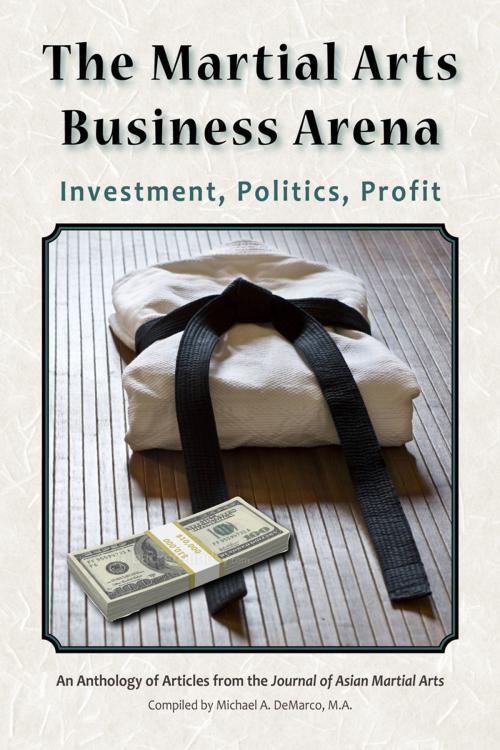The Martial Arts Business Arena
Investment, Politics, Profit
Nonfiction, Sports, Martial Arts & Self Defence| Author: | H. Richard Friman, Yong-jae Ko, Jin-bang Yang, Andrew Tharp | ISBN: | 1230001367133 |
| Publisher: | Via Media Publishing | Publication: | September 30, 2016 |
| Imprint: | Language: | English |
| Author: | H. Richard Friman, Yong-jae Ko, Jin-bang Yang, Andrew Tharp |
| ISBN: | 1230001367133 |
| Publisher: | Via Media Publishing |
| Publication: | September 30, 2016 |
| Imprint: | |
| Language: | English |
Martial art business-related aspects are found at the base level in individual schools and mushroom to a global level in international organizations. This anthology includes writings by professionals who offer information and insights into the financial side of the martial arts. Chapters focus on related practical matters as profit, politics and investment.
In the first chapter, Dr. Richard Friman asks: If the martial arts are supposed to offer paths to personal growth and enlightenment, why are they, in practice, plagued with displays of rampant egos, politics, and battles over turf by their practitioners? The experience of instruction in the United States suggests that the pursuit of the arts is becoming lost in the pursuit of profit.
The next chapter by Dr. Yong Jae Ko presents the evolution of the martial arts industry into a global consumer products industry and examines the application of modern business techniques on this industry, with a particular focus on marketing strategy. It also discusses future opportunities and challenges facing the martial arts industry, and offers helpful suggestions.
In the following chapter, Dr. Ko and coauthor Dr. Jin Bin Yang discuss the global expansion and integration of Asian martial arts. Such factors as sportification and standardization are closely examined as significant driving forces for the growth of the martial arts industry. This chapter also examines important issues influencing the development and the martial arts’ industry future growth.
The final chapter by Andrew Tharp presents the history that influenced the value of Japanese swords as works of art. The Japanese have created a legal system that has preserved their historical weapons in a way no other society has done. Historical sources and current statutes will show how the Japanese created a monopoly that successfully conserved their culture for future generations. Although this Japanese phenomenon is extraordinary, it also serves to show possibilities for those interested in investing in weaponry from other cultures and augments our appreciation of militaria for their aesthetics.
Reading this anthology will help martial art students better understand differences between traditional schools and those that focus solely on profit. Owners can deepen their business acumen and utilize information provided in these chapters to shape their schools’ program. Of course many are influenced by martial art organizations that may be established on a local level, national or international. As an addition to your regular studies of martial art techniques and traditions, the information you’ll find here can certainly broaden one’s view of the martial arts as a business arena.
Martial art business-related aspects are found at the base level in individual schools and mushroom to a global level in international organizations. This anthology includes writings by professionals who offer information and insights into the financial side of the martial arts. Chapters focus on related practical matters as profit, politics and investment.
In the first chapter, Dr. Richard Friman asks: If the martial arts are supposed to offer paths to personal growth and enlightenment, why are they, in practice, plagued with displays of rampant egos, politics, and battles over turf by their practitioners? The experience of instruction in the United States suggests that the pursuit of the arts is becoming lost in the pursuit of profit.
The next chapter by Dr. Yong Jae Ko presents the evolution of the martial arts industry into a global consumer products industry and examines the application of modern business techniques on this industry, with a particular focus on marketing strategy. It also discusses future opportunities and challenges facing the martial arts industry, and offers helpful suggestions.
In the following chapter, Dr. Ko and coauthor Dr. Jin Bin Yang discuss the global expansion and integration of Asian martial arts. Such factors as sportification and standardization are closely examined as significant driving forces for the growth of the martial arts industry. This chapter also examines important issues influencing the development and the martial arts’ industry future growth.
The final chapter by Andrew Tharp presents the history that influenced the value of Japanese swords as works of art. The Japanese have created a legal system that has preserved their historical weapons in a way no other society has done. Historical sources and current statutes will show how the Japanese created a monopoly that successfully conserved their culture for future generations. Although this Japanese phenomenon is extraordinary, it also serves to show possibilities for those interested in investing in weaponry from other cultures and augments our appreciation of militaria for their aesthetics.
Reading this anthology will help martial art students better understand differences between traditional schools and those that focus solely on profit. Owners can deepen their business acumen and utilize information provided in these chapters to shape their schools’ program. Of course many are influenced by martial art organizations that may be established on a local level, national or international. As an addition to your regular studies of martial art techniques and traditions, the information you’ll find here can certainly broaden one’s view of the martial arts as a business arena.















